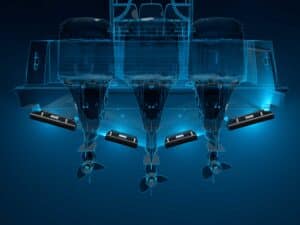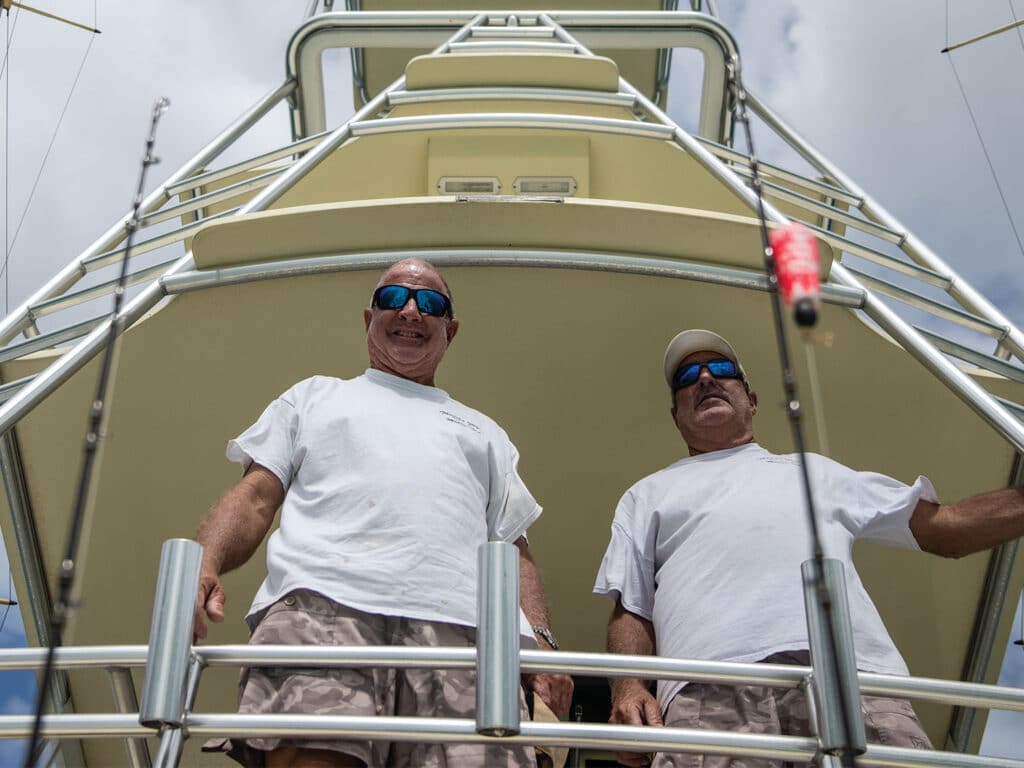
Special delivery: Sign up for the free Marlin email newsletter. Subscribe to Marlin magazine and get a year of highly collectible, keepsake editions – plus access to the digital edition and archives.
Have you ever met someone and instantly knew you’d like them right from the start? Captains and brothers Jimbo and Rick Thomas are the kind of guys who definitely fall into that category. They’ve been a fixture in the South Florida charter fishing and tournament scene for more than four decades, running their yellow 1977 42-foot Post aptly named Thomas Flyer. Like other famous sibling combinations over the years—Peyton and Eli Manning, Eddie and Alex Van Halen, Kyle and Kurt Busch—these two have continued to live their passions every day as they keep putting smiles on the faces of their clients, just as they have done for more than 40 years now.
A Love of the Game
As with nearly every other charter dock in the world, a typical day for the Thomas brothers begins early at Miamarina at Bayside. A thin haze of blue-tinged diesel exhaust hanging in the still morning air means the engines are warmed up and ready as their party for the day arrives, at which point either Jimbo or Rick will surely quip that “you can’t catch ’em at the dock.” But their passion runs considerably deeper than you might think; as true watermen, it’s what drives them to continue to succeed in a career path that is known for razor-thin profit margins; incredibly long, hard hours; and the uncertainty of the clients, the fishing, the weather, and the ever-present mechanical and cosmetic needs of maintaining a hardworking old sport-fisher. But they’d be on the water regardless of whether they were getting paid. If the charter business gives them a lay day, you might find them diving for lobster or stone crabs, or even fishing themselves, crisscrossing each other on Biscayne Bay on their days off—Jimbo in a 25-foot Contender bay boat in matching yellow, or Rick in a 16-foot Dolphin skiff. Vacations inevitably mean more fishing. Guatemala, Panama, Costa Rica, the Bahamas, Alaska. And as of this writing in late November, the duo was enjoying an epic striped marlin bite in Magdalena Bay with friends. Undoubtedly, passion is the underlying theme here.
On the boat, Rick typically runs the cockpit while Jimbo stands above the small padded button of a helm seat on the bridge. Occasionally they switch roles, with Jimbo acknowledging that the deck is tougher because that’s the person who is the primary interface with the charter clients, but it’s all accompanied by some good-natured kidding along the way.
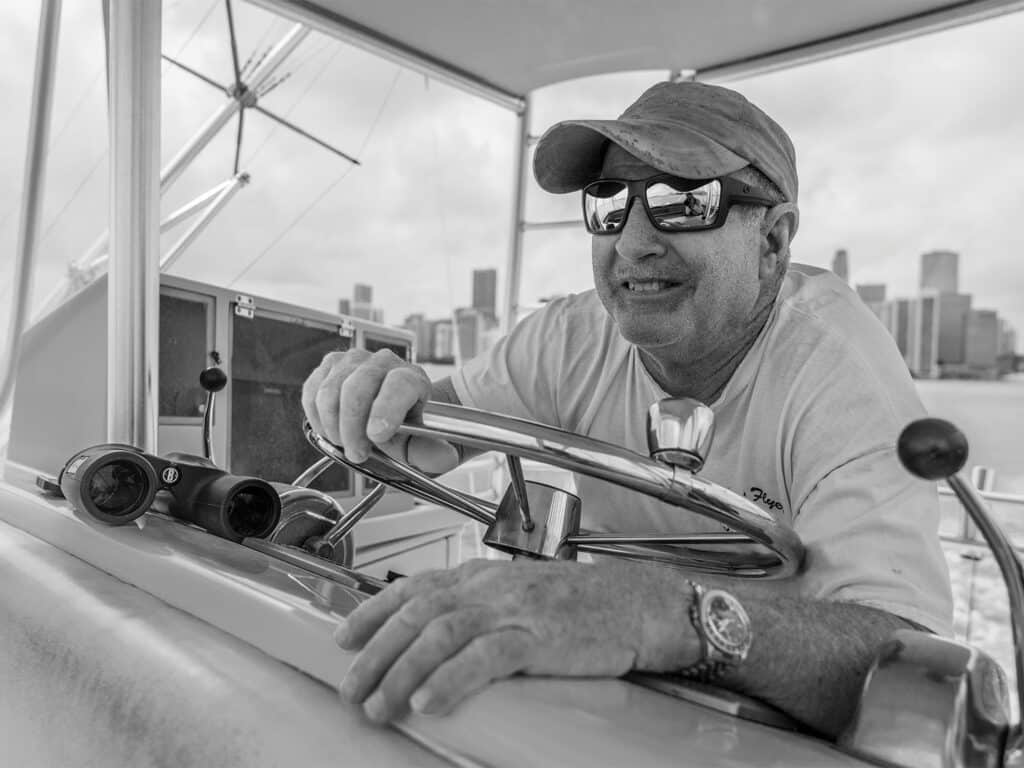
These guys have been together so long they can (and do) finish each other’s sentences, and it’s always amusing when one takes the time to tell a funny story, only to have the other swoop in to steal the punchline. When their day is done, that levity has the potential to increase exponentially with a few longnecks as they tidy up the boat and survey their dock mates’ catches.
The Thomas Flyer charter is all about the experience: lighthearted, no-stress fishing is what their patrons have come to expect. The Thomas boys know that folks put their trust in them to put them on the fish safely, comfortably and, if all is going well, or not so well, with some good-natured humor factored in. But don’t let the casual approach lull you into thinking that this isn’t a productive outfit. These guys are just so damn good they make it all look easy, and it’s the hard work they put in that makes the day of fishing appear virtually effortless.
What’s in store for the day? It depends on what the ocean is willing to offer. They are both experienced enough to resist outsmarting Neptune and will instead take advantage of what’s biting the best. Most of the time they target the South Florida offshore staples of sailfish, dolphin, tuna and king mackerel, but bottomfish are also on the menu because the guys are also excellent at fishing for a variety of grouper, snapper and cobia throughout the year.
A Life on the Water
Jimbo and Rick grew up fishing. Even though their father, Jim Thomas, didn’t have an iron stomach, he would find a way to get the boys on the water, figuring it might be a way to keep them out of trouble. They fished around Miami and the Florida Keys, trailering their old 16-foot scow to where they thought something might be biting. Jimbo, six years older than Rick, also mated on a few boats in his teen years, and knew from those early experiences that the ocean was his calling. Fishing with local legend “Sea Ray” Hathaway and getting advice from Buddy Carey at the original Pier 5 Marina in downtown Miami, Jimbo got his captain’s license at 19 and confessed to his dad that this was his career path, so he and Jim began to search for the right boat at the right price. Their hunt led them to a New Jersey-built Post that was wintering in Palm Beach at the time. So in 1981, a young Jimbo named the boat Thomas Flyer and started running charters with his kid brother in the cockpit. Forty-two years later, not much has changed.Around the same time, another group of ultra-talented hotshots was also coming up through the ranks on the waters off Miami, including Ray Rosher, Brett and John Louie Dudas, Terry Claus, Quinton Dieterle and their numerous contemporaries. The charter scene was competitive yet friendly, for the most part, back in those days, and it has certainly produced some of the finest live-bait fishermen in the sport.
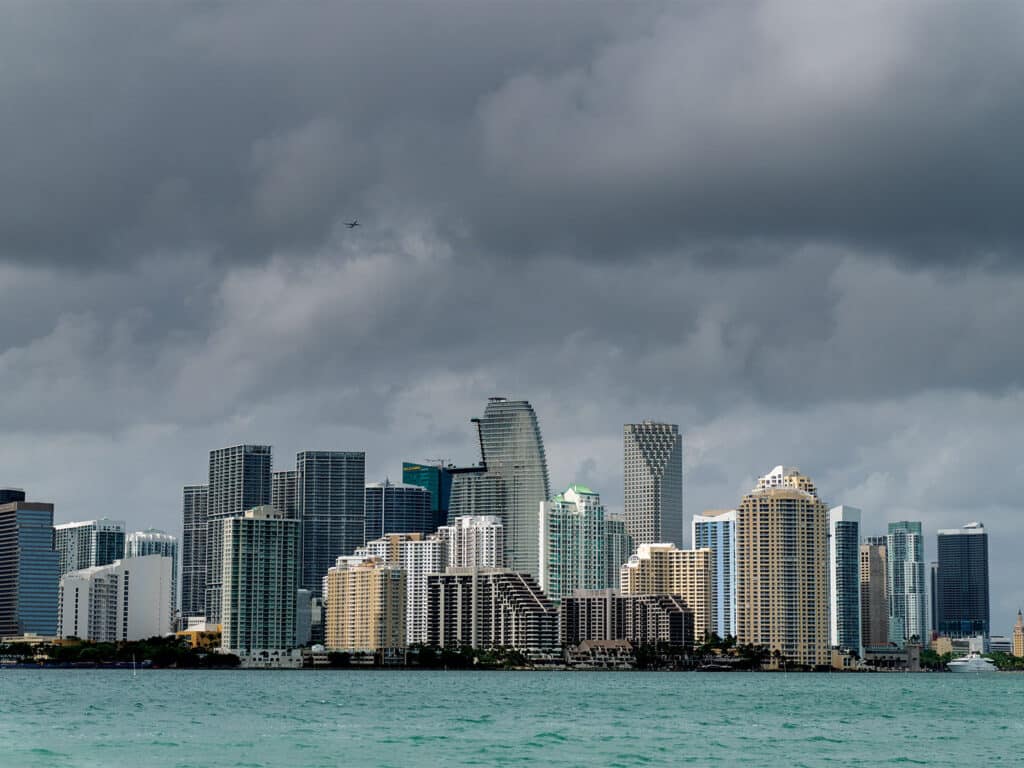
Tournament Time
Maybe a few weeks each year, the Thomas boys get a little more serious and jump in a tournament, where they are always a favorite at the dock for social events. But once it’s time for lines in, they put all that familiarity of the Florida fishery, their boat and equipment to the test. I’ve seen them fish rigger to rigger with bigger boats as they try to muscle their way in on Flyer, with the captain and crew not budging an inch when they’re on a productive sailfish line. Don’t mistake the friendliness at the dock for weakness on the water, because you’ll be sadly mistaken.
One of their regular tournaments is the Reef Cup, held out of the famed Ocean Reef Club in North Key Largo. And while their 42-footer is nearly always the smallest diesel boat in the fleet, Jimbo says it’s one of his favorite events. “We get to fish together and with friends and tournament anglers such as Rob Ruwitch, Steve Cunningham, Albert Castro, Rick Arnold, Sean Brighton and Bill Flynn. It’s always a lot of fun, and sometimes we even make it on the leaderboard,” he says with a grin.
On the radio—tournament time or not—the Thomas Flyer crew has been known to be as sharp as a new bait knife. Having a good run during a tournament and having some misfits for friends can sometimes leave you vulnerable if you are not acutely aware of what lies ahead. This was the case one chilly morning during the Yamaha Contender Miami Billfish Tournament many years ago, when the prize purses weren’t as high as they are today but the bragging rights were perhaps even more valuable. This plays right to those levels of gamesmanship, superstitions and humor that are the touchstones of all tournament fishermen in some form or another. On this day, the Thomas Flyer team was psyched after being the top boat on Day Two, heading into the third and final day of the tournament. The momentum was theirs, and only a couple of sailfish separated them from first place.
The crew arrived at the boat brimming with confidence to close out the last day, but it didn’t take long to notice that some nefarious types had infiltrated the safe confines of their Pier 5 slip. The first giveaway: a banana in every rod holder—an incident that I called Bananagate. But it didn’t stop there. Every hatch, cubbyhole, electronics box, engine room and accessible space from the anchor locker to the lazarette had bananas packed inside. Their dock partners could hardly contain themselves as the boys seemed to remove a truckload of Chiquita’s finest products from every corner of the vessel before heading offshore. Finally, underway and thinking they had removed all of the bad juju from the boat, Capt. Bouncer Smith’s voice came over the radio questioning if they were sure they had gotten all that forbidden fruit, as the tournament fleet howled with laughter. Thomas Flyer had been staging in the basin just inside Miami’s Government Cut with a full stalk of more than 20 bananas hanging from the bow pulpit, completely undetectable from inside the boat, but visible to all the other tournament vessels. The laughter went on for days afterward.
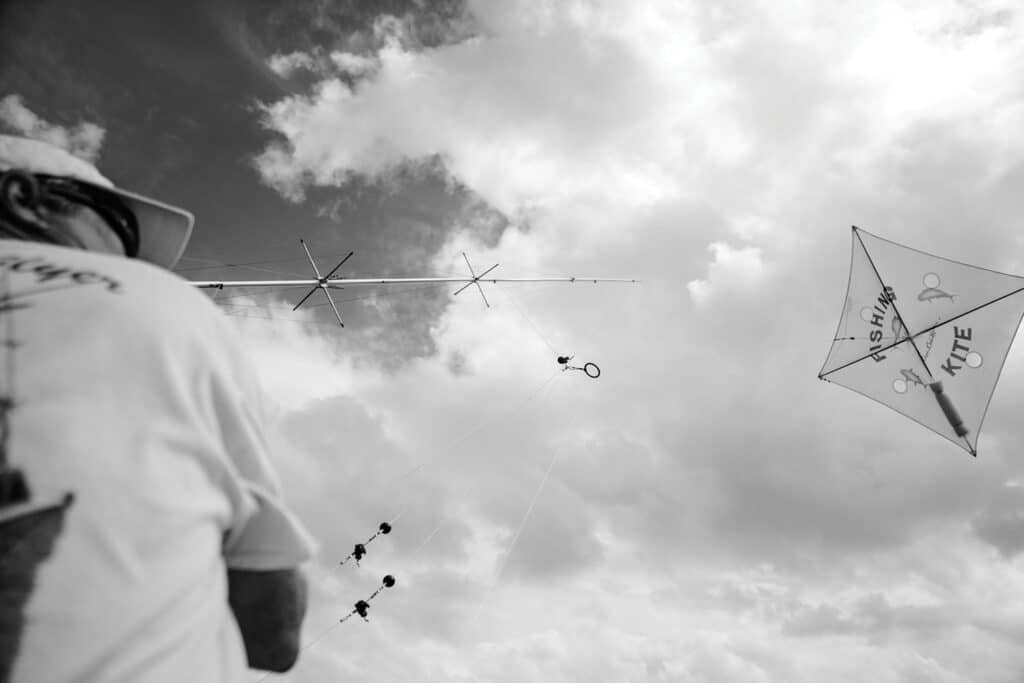
If You’re Not Fishing, You’re Fixing Something
But don’t let all the smiles and jokes fool you—there is always much more behind-the-scenes preparation for each trip, which starts with the boat. The Thomases know every inch of their home away from home, and as Jimbo proudly states, he believes he has more miles on Thomas Flyer than any other 42 Post on the planet.
They usually haul the boat every couple of seasons for maintenance or an improvement of some kind, and as owner-operators, no job is too big or too small. Rebuilding the original Detroit 671s? No problem. They did it six times after getting somewhere between 12,000 and 15,000 hours on each set of rebuilds. They then repowered with new Cummins engines—and did it themselves. They have about 18,000 hours on them now, and Jimbo says, with a characteristic half-smirk on his deeply sun-tanned face, that he’s hoping for another 18,000. At the same time as the Cummins installation, they replaced the aged and heavily pitted tuna tower with a sleeker version, and while they were at it, they also replaced the old windows with new, tempered ones, including the work needed to waterproof the frames and seals. Woodwork and painting are always on tap for any days not fishing, all the while still arriving at the boat each morning before most Miamians are even out of bed.
Read Next: Check out some record-breaking sailfish action from the Florida Keys a few seasons ago.
Smooth Seas and World Records
It’s interesting to hear the perspectives of how fishing back in the day varies from today. Not that long ago, catching a few sailfish could be considered an awesome day, but with better baits, a better presentation with the kites and potentially more sails around, thanks to a longlining ban, double-digit days are not uncommon on the charter dock when the conditions are right.
Rick was also the beneficiary of a large cobia that gave him a second chance at fame, although not so much fortune. The Thomas boys often head out to catch bait in between charters so that they are ready to go when their party arrives. On one such day in April 2010, they checked out some bait spots around the channel markers outside Miami’s Government Cut. Their focus quickly shifted from threadfins to cobia after seeing a number of big fish circling a marker. After Rick boated a nice one, Jimbo noticed a much larger fish, which they hooked and lost. The next day, the same one appeared, pushing its own giant wake as it piled on Rick’s live pinfish. After a 10-minute tussle, they boated the huge cobia, which weighed 121 pounds and set a new IGFA world record.
If you have fished for 40 days, much less for more than 40 years, there will be times that things just don’t go your way. However, in all those trips, Rick and Jimbo say that they have never really felt in danger. Sure, they’ve been out on some hellaciously rough days, but for the most part, common sense and the latest weather forecast will keep you out of serious trouble. It doesn’t mean they witness the same from others whom they share the water with, however.
Jimbo recalls the time he was headed out of Government Cut when he asked Rick if that was a coconut or a head he saw bobbing in the ripping current. As it turns out, his hunch was right, and they tossed a young man a life ring just as he was about to give out and go under, totally spent and exhausted.
Rescuing lost divers seems to be a part-time job during some times of the year as well. The Thomas brothers recalled a time when they saw a Boston Whaler go floating by in the stiff north current off the coast as they worked the Club Wreck off Key Biscayne. They thought it belonged to a couple of divers drifting along as they decompressed below the boat, but then heard a faint whistle in the distance. Sure enough, they picked up the pair who were about to be lost in the quickly fading dusk light. The divers asked them if they had seen a Boston Whaler. Luckily they had, so the divers were reunited with their lost vessel.
The brothers have encountered survivors of sinking boats several times, and it does make you wonder what would have happened to these folks had the yellow boat not been on the water that day.
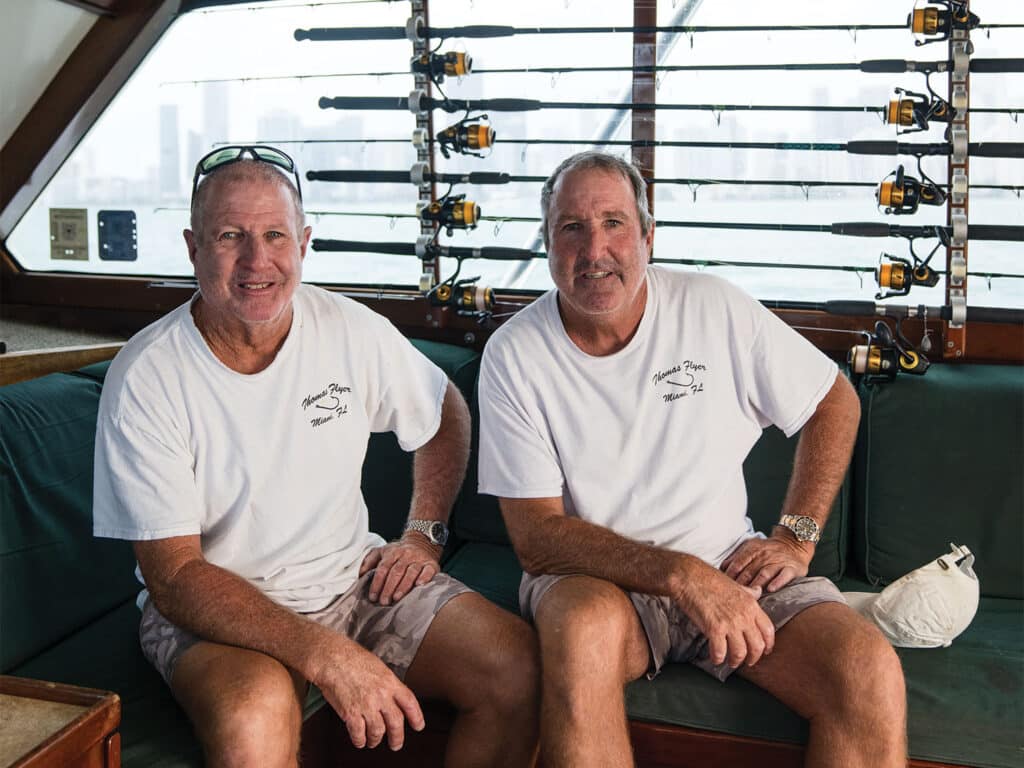
The Future of the Sport
Over the years, the Thomases have seen the fishing change, and admittedly not for the better when it comes to bottom dwellers such as grouper and snapper. They feel it’s a combination of increased fishing pressure, more sophisticated electronics and tackle, and the deterioration of the reefs, as well as the hurricanes and vicious storms that come crashing in.
But not all is lost. A few years ago, Jimbo testified before a special remote session of the United States Congress for his assessment of fishing in Biscayne Bay. His report, along with several other South Florida representatives, was favorable for both the bay and the fish. The brothers take great pride in assisting conservation efforts and protecting the resource that still gives them so much pleasure, and are heavily involved with tagging efforts for both Atlantic sailfish with National Marine Fisheries Service and mahimahi through the Dolphinfish Research Project, where they are consistently one of the top tagging vessels on the East Coast. Jimbo and Rick Thomas say it’s all about supporting an industry and a brotherhood. And no other has given them so much in the past four decades of their lives—both on the water and on Thomas Flyer.



